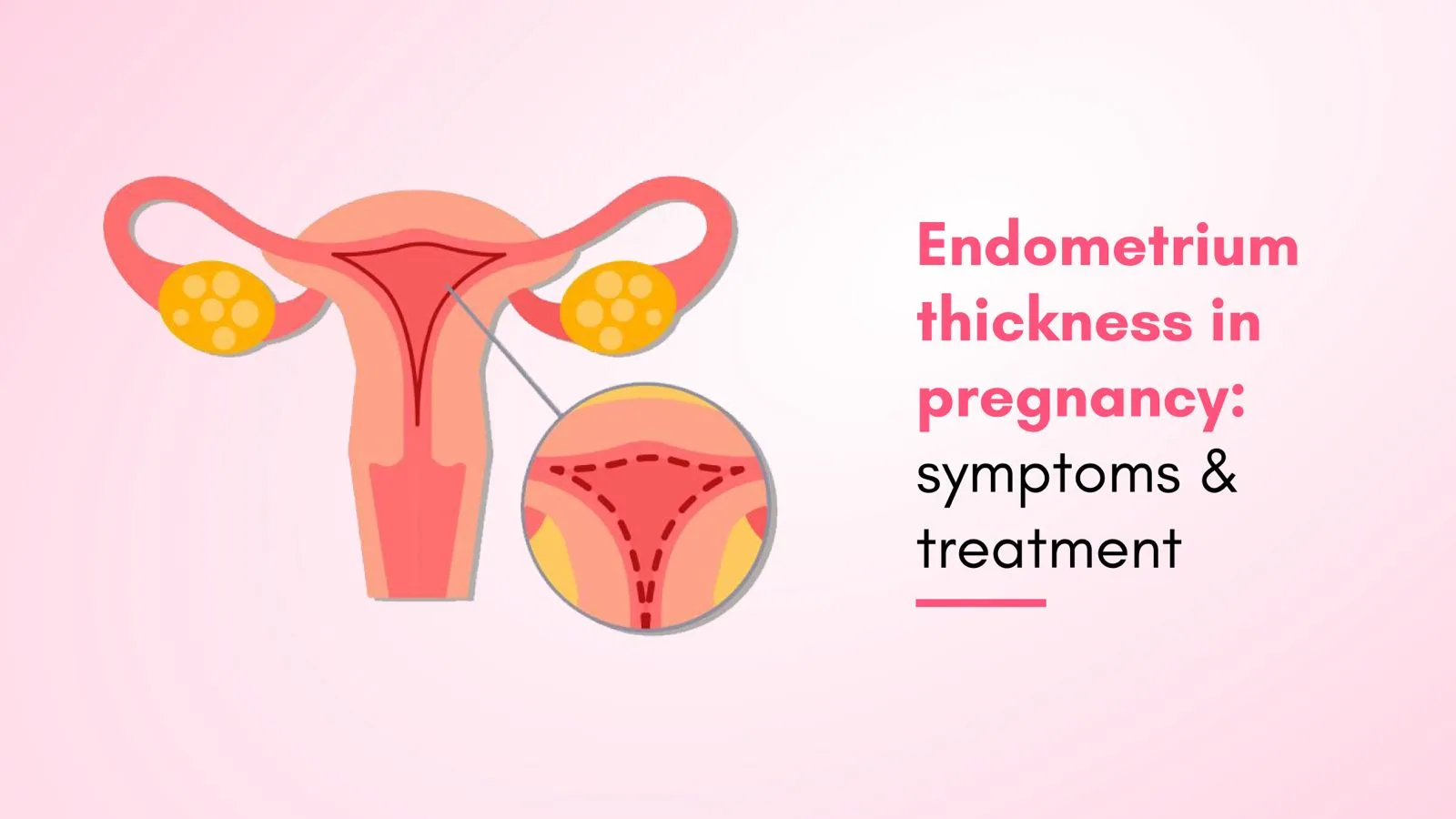The endometrium is an important part of the female reproductive system, playing a key role in her menstrual cycles, pregnancy, and fertility. This inner lining in the uterus should be of appropriate thickness for a normal period cycle and successful pregnancy in the future.
The endometrial thickness changes to prepare for a potential pregnancy. In case the lining remains thin, it can delay the fertilisation process. That’s not it. When a woman is pregnant, the thickness of the endometrium lining changes every month. It is assessed in every ultrasound scan as this thickness can help detect any potential problems in pregnancy.
Thus, it is important to understand the role of normal endometrial thickness, its causes, symptoms, and the course of treatment.
What is normal endometrial thickness?
The normal size of the endometrium in a woman changes throughout her life. Its standard range at a younger age when her periods haven’t started will be different than at an age when she is trying to get pregnant. This lining grows thicker with age.
Here are the endometrial thickness normal sizes in mm at different stages:
- The line is thinnest when a woman is going through her menstrual cycle. So, the endometrial thickness during periods is from 1 to 4 mm.
- After day 5 of the cycle the proliferative phase begins and continues up to ovulation. The duration of the phase varies from person to person.
- Once the woman has reached 14 days into the menstrual cycle, eggs are released, and this is known as the secretory phase. At this stage, the endometrium size reaches up to 18 mm.
In any case, if the endometrial thickness is less than 7 mm, then there can be a delay or complications in pregnancy. Women who are trying to get pregnant should get their endometrium size checked to be assured that everything is okay.
Phases of Menstrual Cycle and Endometrial Thickness
The menstrual cycle is divided into four phases:
- MenstrualThe phase begins with bleeding and goes on for up to 3 to 5 days. This is when the endometrium layering gets thin, and the excess part flows out of the body via blood.
- FollicularThe phase begins on the first day of your menstrual cycle and ends when the ovulation ends. During this time, the endometrium gets thick again as the oestrogen is in full force. The thickness slowly increases.
- OvulationThe endometrial thickness continues to increase during ovulation. It reaches its maximum potential right before ovulation when the oestrogen levels are the strongest.
- LutealOnce the ovulation phase has ended, the follicles rupture and turn into corpus luteum, a structure responsible for producing progesterone. At that time, the endometrial thickness remains relatively stable or may slightly increase during the early part. In case pregnancy doesn’t occur, this lining gradually decreases.
This implies that the endometrium thickness chart during menstruation always fluctuates.
Endometrium in Pre and Post-menopause
As your body is heading towards menopause, it undergoes several changes due to continuous hormonal fluctuations. In these phases, the endometrial thickness is also affected.
Pre-menopause
This is the stage when you are right around the menopausal stage. It begins before the actual menopause arrives, and your ovaries begin producing less oestrogen. This leads to irregular period cycles. During this phase, the endometrial thickness also varies. It turns thinner and experiences irregular shedding.
Post-menopause
This is the stage when you have gone 12 continuous months without a period cycle. In this case, the estrogen level is low, and the endometrium significantly thins. When the regular shedding stops, the risk of endometrial cancer and hyperplasia also reduces.
How to measure endometrium size?
Now that you have a basic understanding of the normal endometrial thickness in mm and how it varies according to your hormonal functioning, let’s get into a little technicality.
How can you check if the normal size of the endometrium in mm has been achieved, especially when you are trying to conceive?
The most common way of measuring your endometrial thickness is through an ultrasound. Your physician will follow this procedure first-hand in case you are facing abnormal vaginal bleeding.
If an ultrasound is not feasible due to the patient’s uterus position or other health conditions, an MRI is recommended. It helps assess the thickness properly and find out the ongoing problems. The thickness looks like a dark line on the MRI or ultrasound report, also known as the endometrial stripe.
When a woman is pregnant, the thickness might fluctuate according to the stage of pregnancy.
There is a direct connection between the endometrium size and pregnancy. Let’s get a clear understanding of it.
Endometrial Thickness and Pregnancy
When your endometrium is of normal size, it indicates a safe and healthy pregnancy journey. The lining should be neither too thin nor too thick for the pregnancy to carry on well. A normal thickness ensures that the embryo is implanted and gets the nutrition needed for the baby’s growth. As the pregnancy progresses, the thickness also increases and reaches between 8mm and 15 mm. In case the thickness is up to 7mm, this can lead to an unsuccessful pregnancy.
That’s why your physician might regularly monitor and see what is endometrial thickness. It will help them understand whether everything is going fine or not.
We have understood that normal endometrial thickness is required for conceiving and giving birth to a child. But what exactly leads to an abnormal thickness?
Causes of thin or thick endometrial lining
Although the endometrial lining changes during pregnancy and menstrual cycle, there are other reasons associated with it. Some of the causes for the thinning or thickening of this uterus lining are:
- Age: As the age increases, the lining of the endometrial gets thinner. This especially happens after menopause.
- Infection: Any kind of inflammation or infection in the uterus can lead to damage to the endometrial lining.
- Hormonal Imbalance: Any fluctuation in the progesterone and estrogen levels directly affects the endometrial lining.
- Past Surgeries: If you have had any surgical procedures (like curettage and dilation) done on your uterus, it can lead to scarring and thinning.
- Other Conditions: Other medical conditions, such as endometriosis, endometrial hyperplasia, and PCOS, can also lead to thinning of the endometrium.
Apart from these factors, diabetes, chronic blood pressure, and obesity are other causes of abnormal thickness.
How can you detect that the endometrium size is unfavourable? Look for signs and symptoms.
Signs and Symptoms
Women with excessively thin or thick endometrium may notice the following changes:
- Vaginal bleeding occurs after menopause.
- Spotting on the vagina, especially between ongoing menstrual cycles, is visible.
- Irregular bleeding during the menstrual cycle. There might be variations in the heaviness and duration of the periods.
- Might find it difficult to conceive or face recurring miscarriages.
- The menstrual cycle is shorter than 21 days or longer than 38 days.
If you are seeing any of the following signs or symptoms, it is important to consult your physician. This is especially important if you are planning a pregnancy soon. The doctor will recommend the right course of treatment so that you do not face difficulty in conceiving.
Treatment
So, what is the procedure for endometrial thickness treatment? Let’s understand.
The exact treatment will depend on the cause of abnormal endometrium size. Although treating the problem is especially important when you want to conceive, the abnormal thickness can lead to other health problems as well.
When the endometrium lining is excessively thin, pregnancy doesn’t progress the way it should. That’s why it becomes important to treat the problem as soon as possible. This can include supplements for improving blood circulation, medications, external injections of human chorionic gonadotrophin; or estrogen oral prescription.
Another basic treatment problem involves oral progesterone therapy. Progesterone hormone is responsible for delaying ovulation and hysterectomy.
Although changes in endometrial thickness are common throughout the life cycle, abnormal symptoms are not to be ignored. If you are witnessing the signs discussed above, it is advisable to consult your doctor.
When to contact a doctor
When does the stage of contacting a doctor come into play?
When you are planning pregnancy, you would want to be sure about everything. Since the endometrial thickness plays an important role in successfully conceiving, a doctor can get the tests done and confirm the same.
Women who are facing abnormal bleeding in their vagina or pelvic pain should consult the doctor. With the right guidance and support, they can adopt the treatment plan and go ahead with the pregnancy journey.
Conclusion
A normal endometrial thickness between 8 mm and 15 mm is required for a successful pregnancy. So, in the case of an abnormal lining, entering a phase of a healthy pregnancy becomes difficult. If you are planning motherhood, consult your physician and begin your treatment journey. Seeking timely medical advice and adopting the right methods can bring back the endometrial thickness to normal size.





























